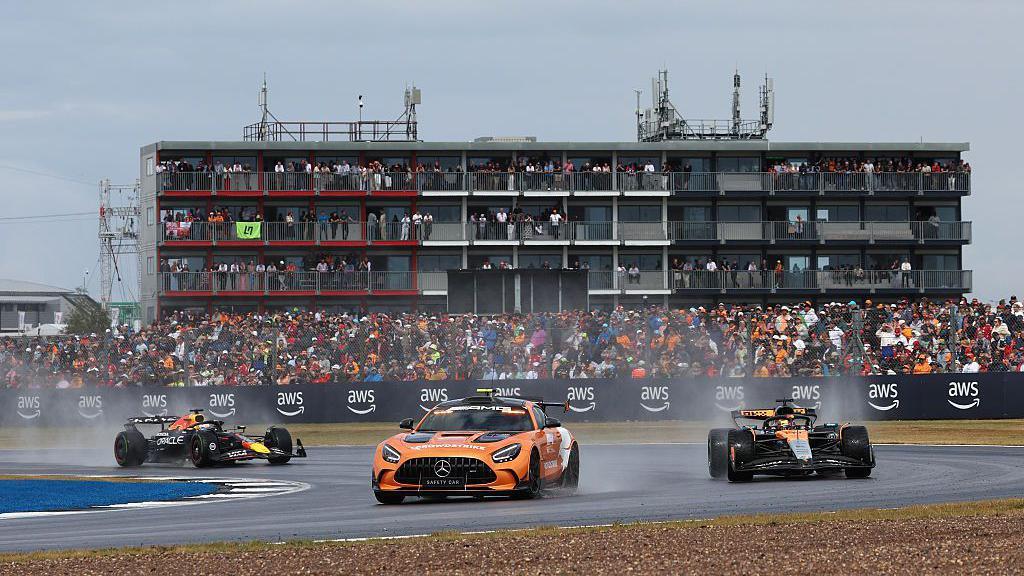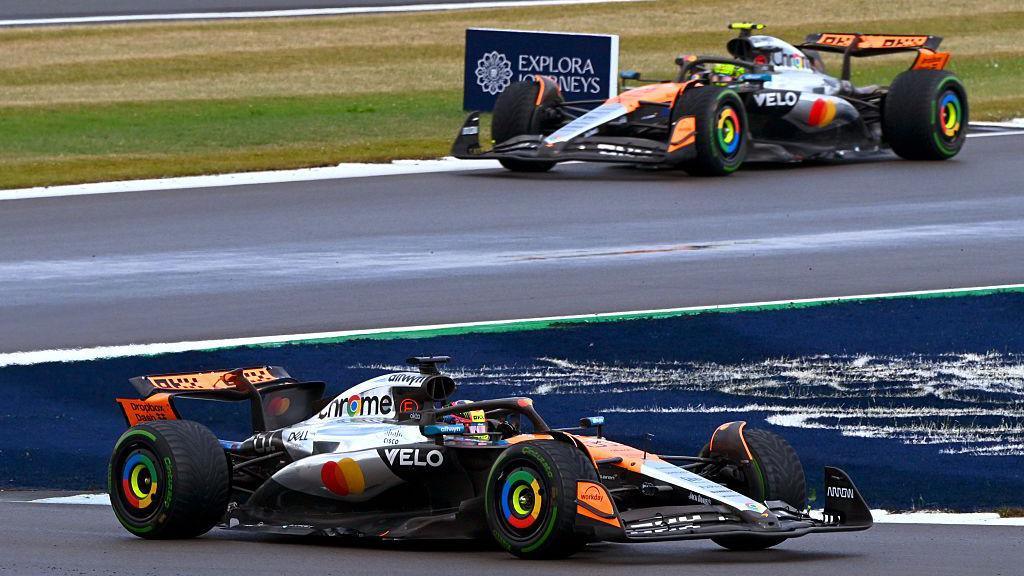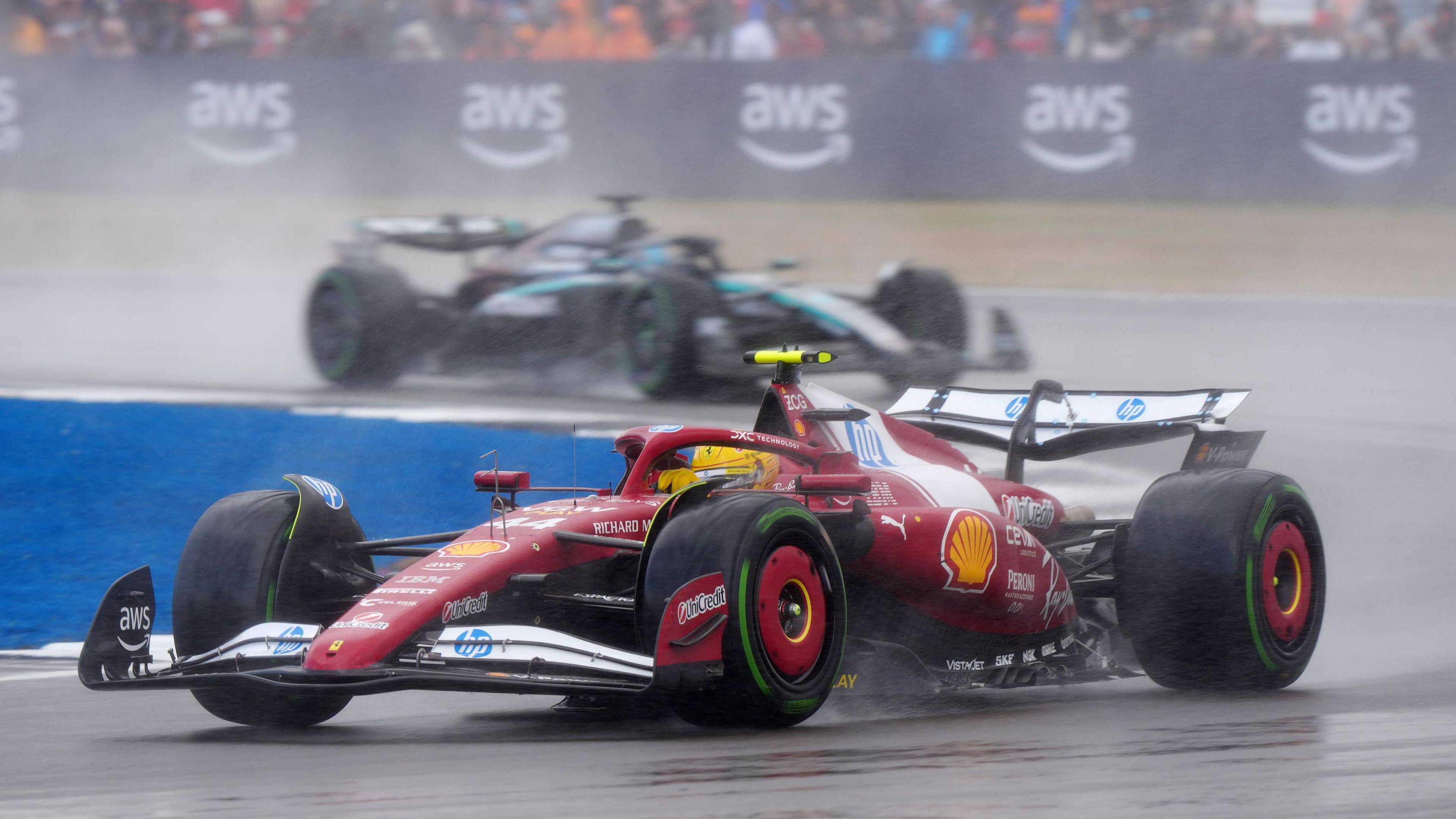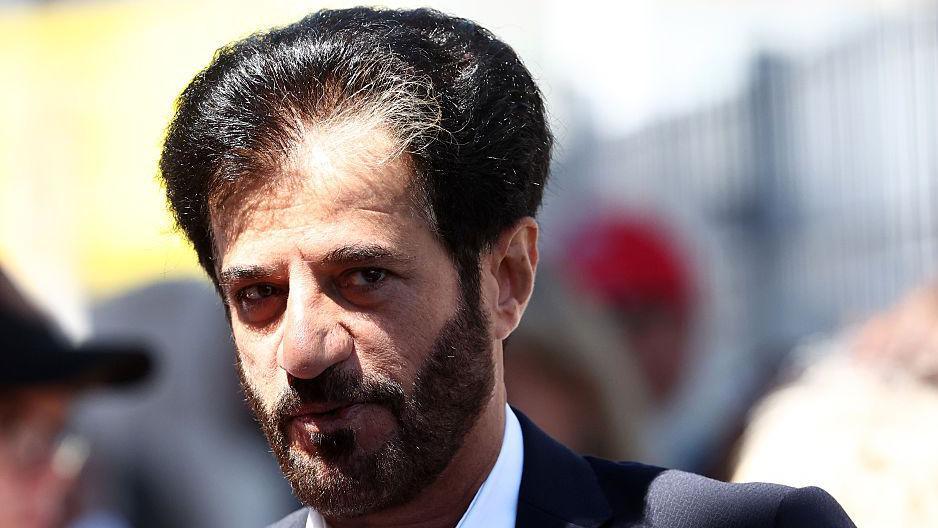Why was Piastri penalised but Russell wasn't?

- Published
Lando Norris led a McLaren one-two to win his first home race at the British Grand Prix.
His team-mate Oscar Piastri was leading before he was handed a 10-second penalty for driving erratically behind the safety car.
There is now a three-week break before Formula 1 heads to round 13 at the Belgian Grand Prix from 25-27 July.
BBC Sport F1 correspondent Andrew Benson answers your latest questions after the race at Silverstone.
Why was Oscar Piastri penalised at Silverstone when George Russell wasn't for his actions behind the safety car in Canada? Is the difference that one was in the wet and therefore visibility limited? - Nick
This is a question Piastri was clearly asking himself after the British Grand Prix, even if he did not say so in quite so many words.
Consistency of stewards' opinions is something teams and drivers are constantly asking for, and on the face of it this does look like a contradiction.
The two incidents were very similar. In Canada, Russell braked and Max Verstappen passed him. At Silverstone, Piastri did the same with the same result.
In Canada, the stewards took no action, and rejected a post-race protest from Red Bull. At Silverstone, Piastri lost the win as a consequence of a 10-second penalty.
There were some differences, however. The brake pressure Piastri applied, while perfectly normal for a braking event behind a safety car, was more than double Russell's. And the conditions were different - wet rather than dry - with the reduced visibility that came from that.
Verstappen made it clear he did not view the incidents that differently, however.
After Sunday's race, he was asked if he thought Piastri deserved a penalty.
"The thing is that it happened to me now a few times, this kind of scenario," Verstappen said. "I just find it strange that suddenly now Oscar is the first one to receive 10 seconds."
Because there was no difference to what Russell did in Canada?
"Well, to the stewards, yes," Verstappen replied.
Piastri said he felt he had done everything within the rules, and implied he had been unlucky to be braking at the same time the safety car lights went out to indicate a restart - the time after which drivers are not allowed "erratic braking nor any other manoeuvre which is likely to endanger other drivers".
Red Bull team principal Christian Horner said: "I wasn't surprised to see him get a penalty. That was what you would expect."
McLaren team principal Andrea Stella said he felt the penalty was "very harsh" and he would discuss it with the stewards.
He said McLaren had made the point during the race it should be looked at afterwards.
"I think we should have checked in detail the opinion of the drivers involved," he said. "We should have checked why the safety car was called in so late and then put together all the elements such that the decision could be as fair as possible."

Oscar Piastri and Max Verstappen follow the safety car during the British Grand Prix
- Published6 July
- Published6 July
If no-one has crashed, or even gone on to wet tyres, then by what definition is the track unsafe? Is F1 a fair-weather sport now? - Martin
The question does not make it clear which particular part of the British Grand Prix it is referring to, but all three times the safety car or virtual safety car was deployed, it was because of a safety-related situation.
The virtual safety car was when Sauber's Gabriel Bortoleto crashed and then pulled off the track.
The first full safety car was deployed when conditions were at their absolute worst. No-one had gone off, but the rain was extremely heavy and visibility was almost non-existent.
These days, it is visibility that usually defines whether officials - and drivers - consider conditions too dangerous for racing.
And the second full safety car, which followed very soon after the restart, was because of a crash. Racing Bulls' Isack Hadjar had crashed into the back of Kimi Antonelli's Mercedes - completely unsighted in the spray - and gone off at Copse.
The car needed to be recovered - hence the safety car. But the incident itself rather proved the point of why the first safety car had been deployed in much worse conditions a few laps before.
- Published6 July
Charles Leclerc is often called the fastest man in F1 over a single lap, but his race results haven't generally lived up to that level for some time. Is it just that Ferrari have been unable to give him a car to regularly compete since he has been with the team, or is it time for an uncomfortable conversation about his racecraft? – Tom
When you look through the data on the offset between Leclerc's conversion rate of poles to wins, almost every time he has failed to do so it has been because of an issue to do with the car or team.
Of course there are a couple of exceptions, where there has been a driver error, but they are a very small minority.
Leclerc is not as rounded a driver as Max Verstappen - few are - but there is no concern about his ability in races.
It's very clear his exceptional qualifying form is down to his remarkable ability over one lap, and that quite often puts him in grid positions that are impossible to sustain in a race, where the average car performance is harder to disguise.
On Sunday, yes, he made the wrong choice in pitting for slick tyres at the end of the formation lap, but so did three other drivers, including George Russell.
Both Ferrari drivers talked after the race about how difficult the car was to drive., external

McLaren lead the constructors' championship with 460 points
Great to see the re-emergence of McLaren - how on earth did they find the way back to the glory days? An exercise in patience, finance or engineering excellence? – Chris
We have explored this story in depth before, and you can read about it here.
The short version is the revival started with Zak Brown's appointment in late 2016 as executive director. He was made chief executive officer of McLaren Racing in early 2018.
He started the restructuring of the team, beginning with sorting out its commercial footing.
There was a time when the team was in serious financial plight. Brown has done a remarkable job compiling an impressive range of financial backers. The team has gone through a few phases of technical restructure, and the infrastructure has been built up over a few years, including a new wind tunnel that came on stream last year.
But the key change Brown made was making Andrea Stella team principal at the end of 2022 - a decision he made when he allowed his predecessor Andreas Seidl to go to Sauber/Audi.
Stella - with Brown as sounding board - decided on another restructure, one of the key parts of which was returning Peter Prodromou to his position as technical director responsible for aerodynamics. Prodromou - a former key lieutenant of Adrian Newey - had been sidelined previously.
McLaren started the 2023 season with a car that was the product of the previous leadership and were close to the back.
Within six months, an upgrade had been put on the car that made it Red Bull's closest rival. It was one of the most remarkable turnarounds ever seen in F1 and, since then, they have gone from strength to strength.
Two more key upgrades followed - in Singapore in 2023 and Miami in 2024 - since when McLaren have been the most consistently fast team.
The recruitment of Rob Marshall - also a former colleague of Newey - from Red Bull for the start of 2024 was another crucial move.
And Stella's wise, considered, calm, erudite, thoughtful leadership has had a powerful effect on the team in a number of ways, including its inclusive culture.
Now, the technical leadership of Prodromou and his fellow technical directors Mark Temple (performance) and Neil Houldey (engineering), along with Marshall, twinned with the incisive leadership of Brown and Stella - two very different characters, who complement each other extremely well - has them flying.
They are also a remarkably open team, without the closed-off defensiveness of many of their rivals (Mercedes excepted). It has been most impressive to witness.
Get in touch
Send us your question for F1 correspondent Andrew Benson
Related topics
- Published6 July

- Published6 July

- Attribution